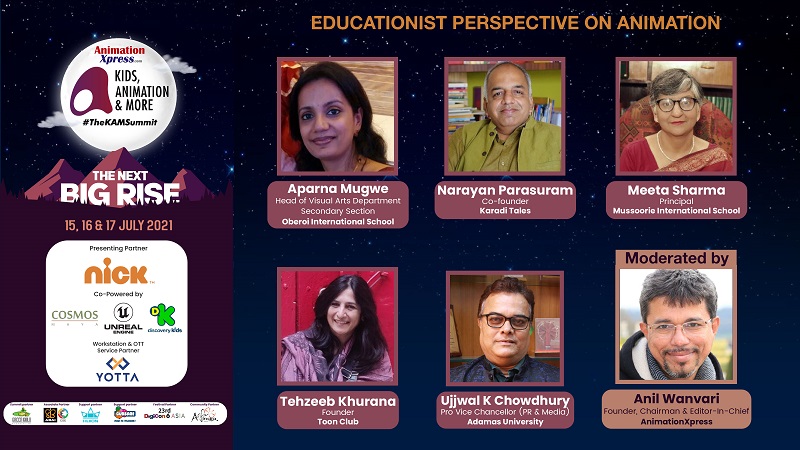
Toon Club founder Tehzeeb Khurana, Karadi Tales co-founder Narayan Parasuram, Mussoorie International School principal Meeta Sharma, Adamas University pro-vice-chancellor (PR & media) Ujjwal K Chowdhury, and Oberoi International School head of visual arts department (secondary section) Apurva Mugwe were the expert panellists who threw light on the educationist perspective on animation, sharing insights on how animation can be a part of education in schools. The session was moderated by Animation Xpress founder, chairman, and editor-in-chief Anil Wanvari.
The discussion kick-started with Tehzeeb Khurana mentioning how it was very difficult initially to incorporate arts in the regular curriculum. But, with the international schools coming into the picture and accepting it, things are getting much better now. “Earlier the focus of education was on STEM and now it’s become STEAM; thankfully art has come in. Very few schools teach animation or art as a subject and include it in their regular curriculum. We have a distance to cover, so it will take some time. In the west and in the European countries, there is a lot more emphasis on art and that is where all the creative innovations are happening. In India, not enough importance is given to art as a subject, it needs to start early, and I guess that is where we are failing.”
Creating art expands a child’s ability to interact with the world around them, and provides a new set of skills for self-expression and communication. “A child has to explore different types of artforms. It has to be 2D, 3D, and digital as well. So, we tell students that they have to develop each skill since there is no right or wrong. Each skill helps you to tap a certain kind of thinking process. If we tell children that there are more avenues and more ways of expressing yourself, you see more work coming out. Then you will see them trying different media as well and not just sticking to one particular aspect,” said Aparna Mugwe.
In an age where visual communication plays a vital role, children are required to acquire visual literacy at an early age in order to be able to learn to judge, interpret and communicate with images in the right way. “I firmly believe in balancing the right and left side of the brain. Visual communication should be a part of primary education. The new education policy doesn’t differentiate between humanities, science, and commerce. So, students can pick their electives from any of the buckets,” commented Ujjwal K Chowdhury.
Narayan Parasuram mentioned, “How can anything in creation not be creative? To categorize any study as creative and non-creative would be a very dangerous approach in education. For me, all faculties in education, be it engineering, arts, science, music, literature; all form one knowledge crucible. There has to be a sadhana, there has to be dedication, work and rigour towards every faculty.” He further commented, “I look at animation as not a separate endeavour but as a phenomenal technology for storytelling.”
Creativity in itself is quite a broad subject. It’s fair to say creativity has been the driving force behind the most groundbreaking innovations of our time. “Schools are killing creativity because of the rigid curriculum they have. Creativity is definitely visual, but first, it has to be in your mind and in your thought process. Creativity is in each one of us; how are we taking it as a school, how are we harnessing it is very very important,” mentioned Meeta Sharma.
Currently, we are heading towards the future of education where in-class teaching is becoming more flexible and innovative. In this development flow, animation has become the ideal teaching aid for teachers to educate children. “I believe that there is a lot of potential in using animation to teach students who find it difficult to learn some subjects. Creators like you can make it simple for them and you’ll be contributing a lot to society,” concluded Anil Wanvari.
Watch the full session here from 0:00
